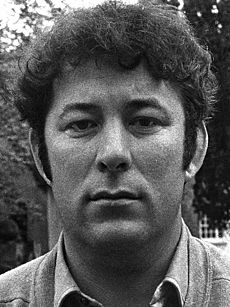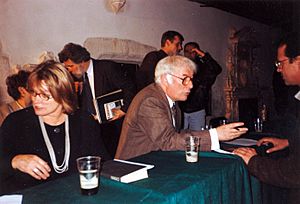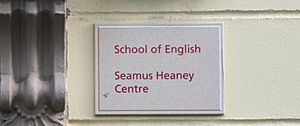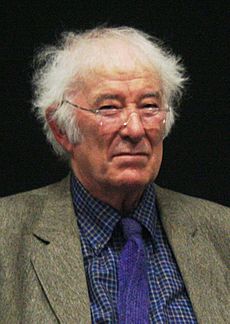Seamus Heaney facts for kids
Quick facts for kids
Seamus Heaney
MRIA
|
|
|---|---|
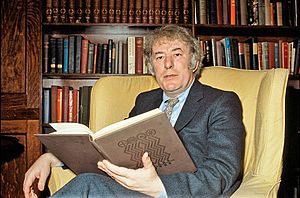
Heaney in 1982
|
|
| Born | 13 April 1939 Tamniaran, near Castledawson, Northern Ireland |
| Died | 30 August 2013 (aged 74) Blackrock, Dublin, Ireland |
| Occupation |
|
| Nationality | Irish |
| Alma mater | Queen's University Belfast |
| Period | 1966–2013 |
| Notable works |
|
| Notable awards |
|
| Spouse |
Marie Devlin
(m. 1965) |
| Children | 3 |
Seamus Heaney (born 13 April 1939 – died 30 August 2013) was a famous Irish poet, playwright, and translator. He won the 1995 Nobel Prize in Literature, which is one of the highest awards for writers. Many people consider him one of the most important poets from Ireland.
One of his most well-known books is Death of a Naturalist, published in 1966. A famous American poet, Robert Lowell, called him "the most important Irish poet since Yeats". Other writers have said he was "the greatest poet of our age." When he passed away in 2013, The Independent newspaper said he was "probably the best-known poet in the world."
Heaney was born in a small area called Tamniaran, in Northern Ireland. His family later moved to Bellaghy. He became a teacher at St. Joseph's College in Belfast in the early 1960s after studying at Queen's University Belfast. This is when he started publishing his poems. From 1976 until his death, he lived in Sandymount, Dublin. He also spent part of his time in the United States from 1981 to 2006.
Heaney taught at Harvard University from 1981 to 1997. He was also the Poet in Residence there from 1988 to 2006. From 1989 to 1994, he was the Oxford Professor of Poetry at Oxford University. He received many awards throughout his life for his amazing writing.
Seamus Heaney is buried in the Cemetery of St Mary's Church in Bellaghy, Northern Ireland. His headstone has a line from one of his poems: "Walk on air against your better judgement."
Early Life and Education
Seamus Heaney was born on 13 April 1939, at his family's farm called Mossbawn. He was the first of nine children. In 1953, his family moved a few miles away to Bellaghy, which became their family home. His father, Patrick Heaney, was a farmer. His mother, Margaret Kathleen McCann, came from a family who worked in a local linen mill. Heaney often wrote about the differences between his father's rural background and his mother's more industrial family.
Heaney went to Anahorish Primary School. When he was twelve, he won a scholarship to St Columb's College, a boarding school in Derry. While he was at St Columb's, his younger brother, Christopher, died in a road accident in 1953. Heaney wrote two poems, "Mid-Term Break" and "The Blackbird of Glanmore", about his brother's death.
As a boy, Heaney played Gaelic football for the team in his birth area, Castledawson GAC. Even after his family moved, he stayed with that club. However, he also became involved with the Bellaghy GAA Club as a teenager, acting in plays and organizing treasure hunts.
Becoming a Poet
Starting His Writing Journey (1957–1969)
Heaney started studying English at Queen's University Belfast in 1957. There, he found a book of poems by Ted Hughes called Lupercal. This book inspired him to start writing poetry himself. He said, "Suddenly, the matter of contemporary poetry was the material of my own life." He graduated in 1961 with top honors.
After university, Heaney trained to be a teacher. He began teaching at St Thomas' Secondary Intermediate School in Ballymurphy, Belfast. The headmaster there, Michael McLaverty, introduced Heaney to the poetry of Patrick Kavanagh. With McLaverty's help, Heaney started publishing his own poems in 1962.
In 1963, Heaney began teaching at St Joseph's College. He also joined the Belfast Group, a workshop for poets. There, he met other poets like Derek Mahon and Michael Longley.
Heaney met Marie Devlin in 1962, and they married in August 1965. Marie was also a teacher and writer. Heaney's first small book of poems, Eleven Poems, came out in 1965. Their first son, Michael, was born in 1966, followed by Christopher in 1968.
His first major collection, Death of a Naturalist, was published in 1966. This book was very popular and won several awards. In the same year, he became a lecturer at Queen's University Belfast. In 1968, Heaney and Michael Longley went on a reading tour, which helped more people discover Heaney's poetry. His second major book, Door into the Dark, was published in 1969.
Full-Time Writing and Teaching (1970–1984)
Heaney taught as a visiting professor at the University of California, Berkeley in 1970–1971. In 1972, he left his teaching job in Belfast and moved to Wicklow in the Republic of Ireland to write full-time. That year, he published his third collection, Wintering Out. His next book, North, came out in 1975.
In 1976, Heaney became Head of English at Carysfort College in Dublin. He moved with his family to Sandymount. His book Field Work was published in 1979. He also published collections of his selected poems and essays. In 1981, he was chosen to be part of Aosdána, a group that honors Irish artists.
Also in 1981, Heaney went to the United States to teach at Harvard University. He received honorary degrees from two universities. In 1984, his mother, Margaret, passed away.
Nobel Prize and Later Works (1985–1999)
Heaney became a permanent professor at Harvard, teaching there from 1985 to 1997. He was also the Poet in Residence at Harvard from 1998 to 2006. In 1986, his father, Patrick, died. Losing both his parents so close together affected Heaney deeply, and he wrote poems about his grief.
In 1985, Heaney wrote a poem called "From the Republic of Conscience" for Amnesty International. This poem inspired the name of Amnesty International's highest award, the Ambassador of Conscience Award.
From 1989 to 1994, Heaney was the Oxford Professor of Poetry. During this time, he split his time between Ireland and the United States. He was very popular, and people would line up to get tickets to his poetry readings. Fans even called themselves "Heaneyboppers"!
In 1990, he published The Cure at Troy, a play based on an ancient Greek story. The next year, he published another book of poems, Seeing Things.
In 1995, Seamus Heaney won the Nobel Prize in Literature. This award was given for his "works of lyrical beauty and ethical depth, which exalt everyday miracles and the living past." He was on holiday in Greece when he heard the news. When he arrived back in Dublin, he was asked how it felt to join other famous Irish Nobel winners like W. B. Yeats. Heaney humbly replied, "It's like being a little foothill at the bottom of a mountain range. You hope you just live up to it. It's extraordinary."
His 1996 collection, The Spirit Level, won the Whitbread Book of the Year Award. He won this award again in 1999 for his translation of Beowulf: A New Verse Translation.
New Millennium and Final Years (2000s–2010s)
In 2003, the Seamus Heaney Centre for Poetry opened at Queen's University Belfast. This center holds many of Heaney's works, including his radio and TV appearances. He also gave a large collection of his writings to Emory University in the United States.
In 2003, Heaney was asked about popular culture figures who made poetry interesting. He praised the American rap artist Eminem, saying he had "sent a voltage around a generation" with his "verbal energy."
In August 2006, Heaney had a stroke. He recovered and even joked about it, but he had to cancel public events for several months. Former President Bill Clinton visited him in the hospital.
Heaney's book District and Circle won the T. S. Eliot Prize in 2006. In 2008, a street in Denmark was named after him. In 2009, he received the David Cohen Prize for Literature. To celebrate his 70th birthday, he recorded an album of himself reading his poetry, which was over 12 hours long!
In 2010, Faber published Human Chain, Heaney's twelfth collection of poems. This book was partly inspired by his stroke in 2006. It won the Forward Poetry Prize for Best Collection.
In 2011, he donated his personal notes and drafts to the National Library of Ireland. He even packed the boxes himself and delivered them with his son.
At the time of his death, Heaney was putting together a collection of his later works. In 2014, Emory University held a major exhibition called Seamus Heaney: The Music of What Happens, celebrating his life and work. In 2015, his family announced they would publish his translation of Book VI of The Aeneid in 2016.
Death
Seamus Heaney passed away in Dublin on 30 August 2013, at the age of 74. He had been ill for a short time. His funeral was held in Dublin, and he was buried later that day in his home village of Bellaghy, next to his parents and younger brother. His son Michael shared that Heaney's last words, texted to his wife Marie minutes before he died, were "Noli timere" (Latin for "Be not afraid").
His funeral was broadcast live on Irish television and radio, and his poetry books quickly sold out in Ireland. Many people, including the President of Ireland, paid tribute to him. His publisher, Faber and Faber, said his "impact on literary culture is immeasurable."
His Work
Writing About Nature and Rural Life
Heaney's books were very popular, making up a large portion of sales for living poets in the UK at one point. His poems often describe the places and people of Ireland, especially Northern Ireland, where he grew up. He said that his experiences growing up in County Derry taught him to trust his own local stories. His early books, Death of a Naturalist (1966) and Door into the Dark (1969), mostly focus on details of country life.
He also wrote many poems about the "bog," which is a type of wetland common in Ireland. These poems, especially in his collection North (1975), sometimes featured ancient bodies found preserved in the bog. These "bog poems" also started to touch on political struggles.
Poetry and Politics
Heaney's poems often hinted at the religious and political differences in Northern Ireland during his lifetime. His books Wintering Out (1973) and North (1975) tried to connect the problems of the Troubles (a period of conflict in Northern Ireland) with history and wider human experiences.
Heaney was seen as someone who tried to bring understanding. He often focused on describing people's lives and voices, showing the "psychic landscape" of the time. His poems sometimes remembered the deaths of family members or friends due to violence.
Heaney wrote a poem called "Requiem for the Croppies" to remember Irish rebels from 1798. He read this poem to both Catholic and Protestant audiences in Ireland. He said that reading it was "silence-breaking rather than rabble-rousing," meaning it helped people talk about difficult history rather than stirring up trouble.
He once turned down the offer to be the Poet Laureate of the United Kingdom (the official poet for the British royal family). He said it was partly for political reasons, explaining that his "cultural starting point" was "off-centre." In one famous poem, "An Open Letter," he wrote:
Don't be surprised if I demur, for, be advised
My passport's green.
No glass of ours was ever raised
To toast The Queen.
This showed his strong Irish identity.
Translations
As a poet and translator, Heaney was interested in the English language as it's spoken in Ireland and how it has changed over time. He explored influences from Anglo-Saxon (an older form of English) in his work.
His translation of the ancient Irish poem Buile Suibhne was published as Sweeney Astray (1984). Heaney's award-winning translation of Beowulf (2000) was very important because it used modern language while keeping the feel of the original Anglo-Saxon poem.
Plays and Essays
Heaney also wrote plays, including The Cure at Troy: A Version of Sophocles' Philoctetes (1991). His 2004 play, The Burial at Thebes, drew connections between ancient stories and modern politics.
His essays, like The Redress of Poetry (1995), show his belief that poetry is important for cultural and personal change. He felt that poetry should help us see reality in new ways, not just describe what's already there.
Poetry for Young Readers
Heaney's work is often studied in schools around the world. He also helped edit two important poetry collections for young people: The Rattle Bag (1982) and The School Bag (1997), both with Ted Hughes.
For The Rattle Bag, Heaney and Hughes wanted to create a book that was simply fun to read. It included silly rhymes, folk songs, and riddles. They wanted to include poems they wished they had found earlier in their own lives. Fifteen years later, The School Bag had a different goal. It was more like a "checklist" of important poems, including works in English, Irish, Welsh, and other languages.
Legacy
The Seamus Heaney HomePlace in Bellaghy is a special center dedicated to celebrating Heaney's life and work. It's a place where people can learn about his poetry and his connection to his home.
His literary papers and notes are kept at the National Library of Ireland, so future generations can study his creative process.
In 2019, a documentary called Seamus Heaney and the music of what happens was shown on BBC Two. In it, his wife and children talked about their family life and read some of the poems he wrote for them. His brothers also shared memories of their childhood, which inspired many of his famous poems.
Prizes and Honours
- 1966 Eric Gregory Award
- 1967 Cholmondeley Award
- 1968 Somerset Maugham Award
- 1968 Geoffrey Faber Memorial Prize
- 1975 E. M. Forster Award
- 1975 Duff Cooper Prize for North
- 1995 Nobel Prize in Literature
- 1996 Commandeur de l'Ordre des Arts et des Lettres
- 1997 Elected Saoi of Aosdána
- 1998 St. Louis Literary Award from the Saint Louis University Library Associates
- 2000 Elected to the American Philosophical Society
- 2001 Golden Wreath of Poetry, given by Struga Poetry Evenings for life achievement in the field of poetry
- 2004 Kenyon Review Award for Literary Achievement
- 2005 Irish PEN Award
- 2006 T. S. Eliot Prize for District and Circle
- 2007 Poetry Now Award for District and Circle
- 2009 David Cohen Prize
- 2011 Poetry Now Award for Human Chain
- 2011 Bob Hughes Lifetime Achievement Award
- 2012 Griffin Poetry Prize, Lifetime Recognition Award
See also
 In Spanish: Seamus Heaney para niños
In Spanish: Seamus Heaney para niños
- List of Nobel laureates in Literature
- List of people on stamps of Ireland


